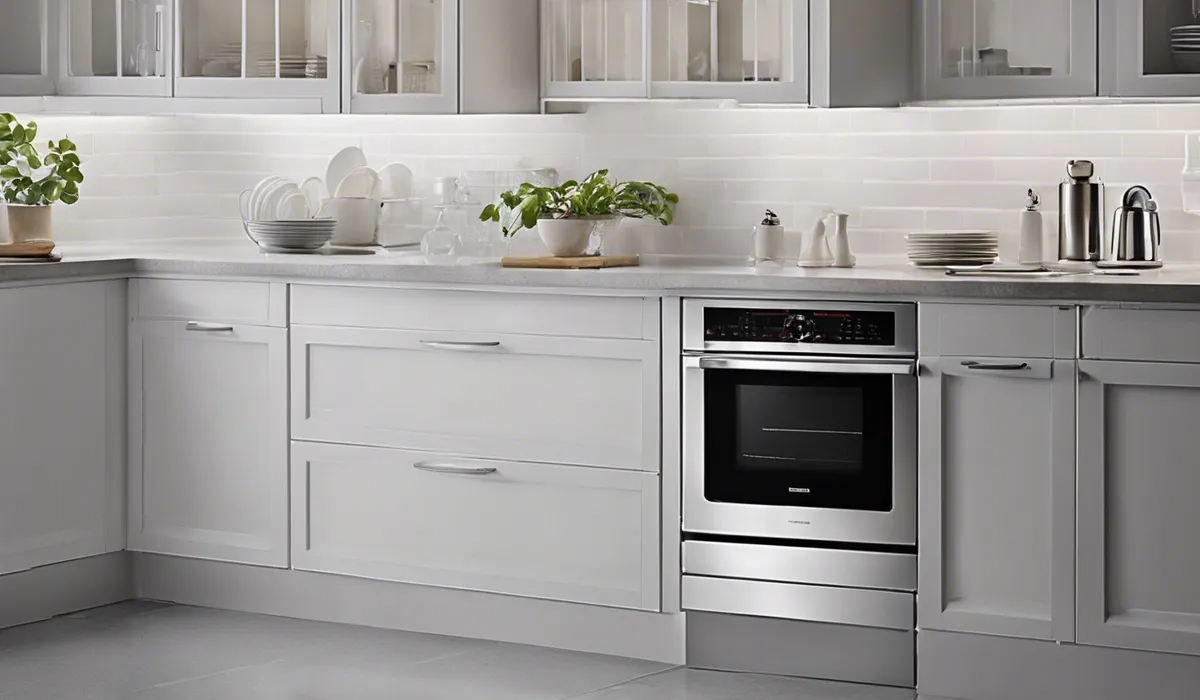How to Manually Drain Dishwasher: Quick Fix Guide
To manually drain a dishwasher, remove the bottom dish rack to access the drain. Clear any food debris or blockages. Place a towel under the dishwasher to catch spills. Use a sponge or cup to scoop out the remaining water from the bottom. Check the drain hose for clogs and clean if necessary.
Step-by-Step Guide to Manually Draining Your Dishwasher

Turn off the Power
Before beginning any maintenance on your dishwasher, it’s crucial to ensure your safety. Start by turning off the power to your dishwasher.
You can do this by unplugging it from the wall outlet or switching off the breaker that controls the dishwasher in your home’s electrical panel.
This prevents any electrical accidents while you work on draining the appliance.
Remove the Bottom Dish Rack
Slide out the bottom dish rack to gain full access to the bottom of your dishwasher. This will allow you to reach the water that needs to be drained as well as the dishwasher filter and drain.
Removing the rack is simple; just pull it towards you and lift it out of the dishwasher.
Use Towels to Soak Up the Water
Place towels on the floor in front of your dishwasher to absorb any water that may spill while you are draining it.
Towels can also be used inside the dishwasher to soak up standing water.
Press them gently against the bottom to absorb as much water as possible before you begin bailing out the remaining water.
Locate the Drain and Remove Any Clogs
Look for the drain inside your dishwasher, which is typically located at the bottom. Check for any visible clogs, such as food particles or debris, that could be causing a blockage.
You can use a plastic utensil or your fingers to remove the debris. Be careful not to damage the drain while clearing the clog.
Bail Out Remaining Water with a Cup or Sponge
After removing the bulk of the debris, use a cup or a sponge to scoop out the remaining water. Squeeze the water into a bucket or sink.
This might take a little time, but it’s important to remove as much water as possible to prevent mold and mildew growth.
Check the Drain Hose for Blockages
Inspect the drain hose that connects to your dishwasher. This hose can sometimes become kinked or clogged with food particles or grease.
If you find a blockage, carefully remove it to ensure that water can flow freely through the hose. You may need to disconnect the hose from the dishwasher or sink to clean it thoroughly.
Cleaning the Dishwasher Filter and Drain

Locate and Remove the Dishwasher Filter
Find your dishwasher’s filter, which is usually situated at the bottom of the machine, near the drain.
Most dishwasher filters can be easily twisted or lifted out. Once you have located it, remove the filter to clean it.
Rinse the Filter Under Running Water
Hold the dishwasher filter under running water to rinse away any loose debris and grime.
Use a gentle stream of water to avoid damaging the filter. This step is crucial for maintaining the efficiency of your dishwasher.
Use a Soft Brush to Remove Debris from the Filter
If the filter has stubborn debris stuck to it, use a soft brush, like an old toothbrush, to scrub it clean.
Gently brush the mesh and plastic components to remove any particles without causing any tears or damage.
Clean the Drain Area in the Dishwasher
With the filter removed, you now have better access to the drain area. Use a damp cloth or sponge to clean around the drain. Ensure that you remove any grime or deposits that could cause future clogs.
Replace the Filter and Secure It Properly
After cleaning the filter, place it back into its designated area in the dishwasher. Make sure it fits snugly and is locked in place to prevent any potential dish damage or filtration issues.
Preventing Future Drainage Issues

Run Hot Water in the Sink Before Starting the Dishwasher
By running hot water in your sink before starting the dishwasher, you ensure that the appliance has immediate access to hot water, which can help break down food particles and grease more effectively.
This simple step can improve cleaning performance and prevent clogs.
Ensure Proper Dishwasher Loading Techniques
Loading your dishwasher correctly is essential for both cleaning efficiency and preventing drainage issues.
Make sure that dishes do not block the spray arms and that the filter is not obstructed by large items. Avoid nesting bowls and spoons, as this can trap food and lead to clogs.
Regularly Clean the Filter and Check for Clogs
Regular maintenance of your dishwasher’s filter is essential to keep it running smoothly.
Aim to clean the filter every month or so, depending on usage, to prevent food build-up and potential drainage problems.
Use the Right Detergent and Avoid Overusing It
Selecting the right detergent for your dishwasher can make a significant difference.
Some detergents are specifically formulated to prevent residue that can clog your machine.
Moreover, always measure the detergent according to the manufacturer’s guidelines to avoid excess suds that can lead to drainage issues.
Consider Using a Dishwasher Cleaner Periodically
Even with regular cleaning, your dishwasher can benefit from a commercial dishwasher cleaner.
These cleaners are designed to remove hard water deposits, grease, and soap scum that can lead to clogs. Using a cleaner every few months can keep your dishwasher in top condition.
FAQs About Manually Draining a Dishwasher
How do I start draining my dishwasher manually?
To begin manually draining your dishwasher, first remove the bottom dish rack to access the drain, and then clear any food particles or blockages that may be present.
What should I do to prevent water from spilling onto the floor?
Place a towel under the dishwasher before starting to catch any spills that may occur while you scoop out the water.
What is the best way to remove the water that remains at the bottom of the dishwasher?
Use a sponge or a cup to scoop out the remaining water from the bottom of the dishwasher until it is mostly empty.
How can I check for and clear clogs in the dishwasher drain hose?
After scooping out the water, check the drain hose for any clogs by inspecting it and clean it if necessary to ensure water can flow through it freely.
What should I do if I find food debris or blockages in my dishwasher drain?
Clear any visible food debris or blockages from the dishwasher drain by hand or with a tool, such as a straightened wire hanger, to allow water to drain properly.
Final Thoughts
Manually draining a dishwasher involves removing the bottom rack to access the drain, clearing any obstructions, and placing a towel underneath to catch drips. Water should be scooped out with a sponge or cup.
Additionally, inspect and clean the drain hose to ensure it is free from clogs, ensuring proper drainage for future use.





